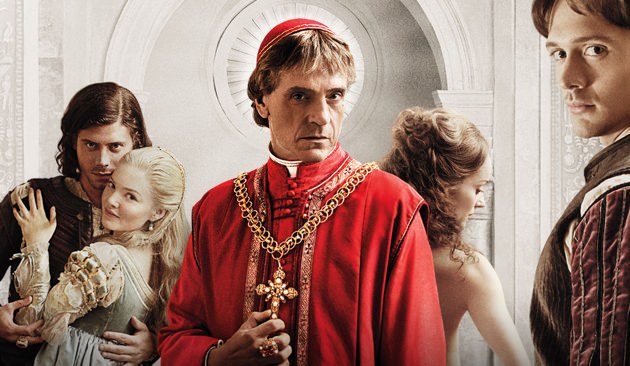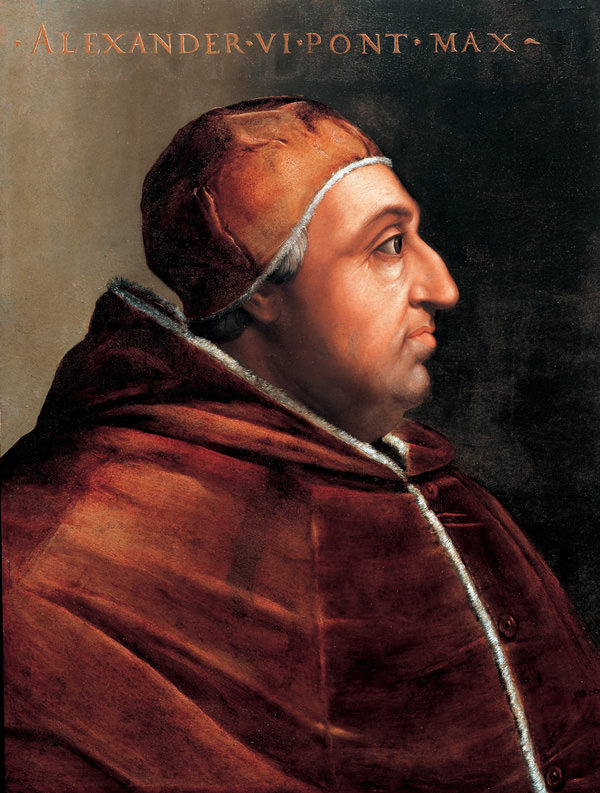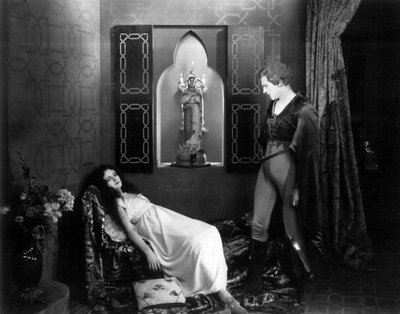Caravaggio novels, as a knowledgeable friend has observed, are not only unrelentingly bad, but bad in the same way (this friend remains nameless in order to avoid the remonstrances of outraged Caravaggio novelists and Derek Jarman). A related case of badness afflicts The Borgias, the new Showtime TV series that bears the name of director Neil Jordan and improbably stars Jeremy Irons as the patriarch of the powerful fifteenth- and sixteenth-century clan. In forty-five-minute doses, The Borgias presents viewers with a veritable banquet of badnesses: the by-definition badness of bodice-ripping costume drama, the badness of the directorial ego-trip, the badness of Low Budget/High Pretensions, the badness of gratuitous violence, and that sovereign badness of not knowing where you want to go because you don’t know where you are in the first place.
The Borgias is clearly modeled on an earlier miniseries about a powerful clan, The Tudors, although the Spanish Borja family, transplanted to Italy in the fifteenth century, produced popes rather than kings (Borgia is the Italian version of their name). Director Jordan intends to capitalize on some of the lurid aspects of the Borgia legend: the papal children, the rigged conclaves, the rumors of incest, the perils of old men and psychotic boys invested with too much power, and above all the contrast between the Church, with all its aspirations to heavenly glory, and the down-and-dirty realities of human existence. Jordan takes credit for The Borgias’ concept and its script, noting in passing that “History is for the textbooks” before going on to assert that the series is really the product of his imagination.
But why, then, bother with the Borgias? To capitalize on their sinister reputation? Oedipus, the Ewings of Dallas, the Corleones and the Sopranos seem not to have suffered from having been made up. And having decided to evoke Borgias, why not mine their story for all its lurid potential? The first Borgia pope, Calixtus III, was too old when he took office to do much except appoint his nephew Rodrigo to the highest office in the Vatican’s financial operation: Vice Chancellor of the Apostolic Chamber—but Rodrigo made the most of his opportunity. In 1492, after thirty-five years as Vice Chancellor, he was elected pope, and the stories began to swirl, beginning with the fact that he had so many children (five) and used his high office to set them up in the world. Celibacy, in his book, meant not marrying; chastity was another matter entirely. (Many Renaissance popes had children, including Pope Alexander’s rival, Giuliano della Rovere, the future Julius II.)
The Borgia children themselves ranged from sociopaths—Rodrigo’s eldest son Juan, Duke of Gandia, amused himself by riding around Rome killing small animals—to charmers, as his thrice-married daughter Lucrezia seems to have been. And then there was the second son, Cesare: appointed cardinal as soon as his father became pope, Cesare was unhappy in his job, and after Juan was found floating face down in the Tiber in 1499 (murdered, most people assumed, by Cesare), Number Two Son took over his brother’s roles of family man and man at arms. He married a French princess in 1499, but he promptly left her behind to pursue his real ambition: a state of his own in Italy. With Niccolò Machiavelli as his advisor, he spent the next four years wreaking havoc as he tried to conquer a succession of Italian city-states.
But the reigns of Renaissance popes rarely last long. Both Cesare and his father took ill after accepting a dinner invitation in the Roman garden of Cardinal Adriano Castellesi on a summer day in 1503. Cesare lived, but never regained his strength, physically—although the real culprit may have been his syphilis—or politically. Pope Alexander fared still worse: he swelled up, turned purple, and died. His successor—after the twenty-six-day reign of the sickly Pius III—was Julius II, the papa terribile who secured his position by bribery and did his best ever after to vilify the Borgias. That bit of dynastic character assassination came along with some other interesting projects: Michelangelo’s Sistine Ceiling, a new St. Peter’s, and a suite of apartments decorated by Raphael. Rome has never been the same since.
Neil Jordan claims to have read this saga (though he apparently failed to notice the birth order of the four Borgia children, which is pretty fundamental stuff). What could have possessed him to think, then, that his own head contains more mysteries than the alternative universe of the Italian Renaissance? We could have had Leonardo, Michelangelo, Raphael, Machiavelli. Instead we get the Borgias filtered through the brainpan of a twentieth-century lapsed Catholic Irishman. In this telling, men, for the most part, are skanky creeps, women either madonnas or Jezebels. (In the real world, Pope Borgia’s erstwhile mistress, Vannozza Cattanei, wasn’t huddling at home with the kids pining for her clerical paramour, as Jordan would show her; she was running a chain of hotels with her second husband—she got over Rodrigo ages before he became Pope.)
Advertisement
Jordan grafts the religious conflict of the Irish Troubles onto the visual world of Pirates of the Caribbean (as in a tableau of stuffed human corpses set up to recreate the Last Supper), with gross helpings of cable-television ultra-violence thrown in at least twice an episode—though these whippings, stabbings, and torments are nothing compared to the kinds of shocking cruelty Renaissance brutes actually dished out. (Benvenuto Cellini’s idea of a practical joke: knife someone in the back and laugh). The opening scene of the series, for instance, shows the last breaths of Pope Innocent VIII, but not the three young boys who supplied the dying pontiff with transfusions and died along with him. (We do get Don Carlo Gesualdo’s gorgeous motet O vos omnes as a soundtrack—even if Don Carlo wouldn’t write it for another eighty years.) There is also a fair amount of sex by US standards, though nothing like the bounding bimbos that Italians see on Prime Minister Silvio Berlusconi’s private channels.
With almost comical earnestness, the director aims for elevation to the realm of Art by resorting to the hoary cliché that all historical dramas in English must sound like Masterpiece Theatre. Only thus could he have envisioned Jeremy Irons as Rodrigo Borgia, a role for which Irons must have known from the beginning that he was miscast.
Rodrigo Borgia was a short, stout, thick-lipped, big-nosed Spanish voluptuary; Irons, as lean and elegant as men are made, exudes passion aplenty, but that passion burns with the steely flame of the North, not with Latin fire. Indeed, Irons should have been cast as Borgia’s nemesis, the future Pope Julius II, a handsome and pensive man; Jordan’s choice for that role, lean, austere Colm Feore, has the physique of famously skinny cardinal Ascanio Sforza. Holliday Grainger as Lucrezia Borgia confirms what most of her contemporaries said about the Pope’s daughter: she was a genuinely likable person, despite her dreadful menfolk. But Cesare Borgia really should have been someone like Johnny Depp, not the squeaky-clean Canadian Francois Arnaud. Depp may be twenty years older than Cesare in 1492, but he knows how to elevate a potboiler by taking it right over the top, and there he and Irons—or in a better Borgia world, he and Alan Rickman as Pope Alexander—could have sparred in some Olympian realm of irony.
Casting aside, there is a more fundamental issue at stake when Tinseltown confronts historical drama: history has never been about lavishly costumed predictability; it was and is about life, and life is a fathomless mystery. Take Rodrigo Borgia’s election to the papacy: Jordan knows that cardinals couldn’t confer in the Sistine Chapel, but he seems unaware that they could and did confer in the latrines (which must have been in the stairwells just outside). Indeed, the “happy house” is probably the place where Rodrigo Borgia did most of his campaigning for the papacy, not by ordering Cesare Borgia to put rolled-up notes in the prelates’ turkey roasts, a cinematic touch that smells more of Dickens or Conan Doyle than Machiavelli.
Meanwhile, one of the chief draws of the Borgia story, its Italian setting, has been utterly sacrificed—no doubt for budgetary reasons. The most basic thrill of the series should be a few atmospheric shots of the Seven Hills. But The Borgias is shot in Hungary, leaving the action continually enshrouded by the mists of the Danube—horsemen ride headlong through the Puszta with a purple computer-generated Vesuvius hanging in the background, pretending they are in Naples.
Dealing with history tends to make for better historical drama than faking it: John Hurt’s hallucinatory Caligula in the BBC’s 1976 I, Claudius, like the Livia of Siân Phillips in that same series (“Claudius, I want to be a goddess”) were real ancient Romans—or at least a creditable High Camp version thereof—unforgettably alien figures from an alien time. Knowledge, indeed, poses no danger to creativity, as Monty Python can attest. The Pythons also showed that messing with history can produce brilliant results, but it does help to know your material before you mess with it. Covington Cross, a short-lived, hilarious 1992 television series raised costumed anachronism to high art, with a fourteenth-century tomboy (Ione Skye) clad in clanking armor, a gay Crusader, Jewish shtick and sparkling dialogue.
Advertisement
The Borgias shone in the 1926 Hollywood spectacular Don Juan (the first movie with its own sound track, all music), in which John Barrymore, as the Don, on spring break from his studies at the University of Pisa (!), is wooed by Lucrezia Borgia, falls for Mary Astor as the virginal (and fictitious) Adriana Della Varnese, and leaps gloriously off a balustrade in two-tone tights, profile slicing the air, to skewer an evil henchman of Cesare Borgia. Borgia himself is played by the Swedish-American actor Warner Oland, whose Tatar-exotic features were soon to find immortality as Charlie Chan. The lightness of being with which Barrymore plies his rapier, Oland’s palpable alcoholic glee at playing a real villain, Myrna Loy vamping in her cinematic debut as Lucrezia’s sexy servant, fifteen-year-old Mary Astor trembling at Barrymore’s touch (she said that there was no part of her body that he did not make sing during the making of the film)—these glimmers of joie de vivre still make Don Juan a romp of endlessly fresh appeal.
I thought I could derive pleasure watching Jeremy Irons doing just about anything, including selling cars—as he now does in an Italian TV commercial. But I deserted The Borgias after the third episode.
A second Borgia TV series, directed by Tom Fontana and in production now, may pride itself on its (comparative) historical accuracy, but Hollywood Variety has intercepted the director filming a scene where Juan Borgia rapes Lucrezia—that five-hundred-year-old canard—while boasting that he “can’t resist a good rape.” In the Renaissance, that statement would have been isolated from its context, turned into Latin verse, and pasted on walls all over Rome, condemning its maker to watch his back for the rest of his life.




